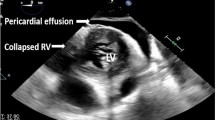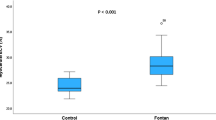Abstract
Elevated magnetic resonance elastography (MRE)-derived liver stiffness may be associated with worse outcomes in people with Fontan circulation. We sought to evaluate the association between liver stiffness and Fontan failure or portal hypertension. Single center cross-sectional retrospective study of people with Fontan circulation who underwent MRE between 2011 and 2020. The cohort was divided into adult (age ≥ 21 years) and pediatric (< 21 years) groups. Fontan circulatory failure (FF) was defined as any of the following: death, transplantation, ventricular assist device, heart failure symptoms requiring escalation of diuretics. Radiologic portal hypertension was defined as the presence of one or more of the following: splenomegaly, ascites, or gastrointestinal varices. 128 patients were included (average age = 22.6 ± 8.7 years) and 58 (45%) were children. Median liver stiffness was 4.3 kPa (interquartile range (IQR) 3.8–5.8) for the entire cohort. Thirty patients (23%) developed FF (16 adults, 14 children). Liver stiffness was higher in adults with FF compared to those without FF (4.9 (IQR 4.0–6.0) vs. 4.2 (IQR 3.8–4.7) kPa, p = 0.04). There was no difference in liver stiffness between pediatric patients with and without FF (4.4 (IQR 4.1–5.4) vs. 4.4 (IQR 3.8–5.0), p = 0.5). Adults with radiologic portal hypertension and adults with moderate or severe atrioventricular valve regurgitation had higher liver stiffness than adults without. MRE-derived liver stiffness is associated with atrioventricular valve regurgitation, portal hypertension, and poor clinical outcomes in adults with Fontan circulation. There was no association between liver stiffness and FF in pediatric patients. This difference may be due to the progressive nature of Fontan-associated liver disease.




Similar content being viewed by others
Data Availability
Available upon request.
Code Availability
Not applicable.
References
Fredenburg TB, Johnson TR, Cohen MD (2011) The Fontan procedure: anatomy, complications, and manifestations of failure. Radiographics 31:453–463. https://doi.org/10.1148/rg.312105027
Alsaied T, Bokma JP, Engel ME et al (2017) Factors associated with long-term mortality after Fontan procedures: a systematic review. Heart 103:104–110
Book WM, Gerardin J, Saraf A et al (2016) Clinical phenotypes of Fontan failure: implications for management. Congenit Heart Dis 11:296–308. https://doi.org/10.1111/chd.12368
Gordon-Walker TT, Bove K, Veldtman G (2019) Fontan-associated liver disease: a review. J Cardiol 74:223–232
Daniels CJ, Bradley EA, Landzberg MJ, et al (2017) Fontan-associated liver disease: Proceedings from the American College of Cardiology Stakeholders Meeting, October 1 to 2, 2015, Washington DC. Journal of the American College of Cardiology. Elsevier USA, pp 3173–3194
Morisaka H, Motosugi U, Ichikawa S et al (2018) Magnetic resonance elastography is as accurate as liver biopsy for liver fibrosis staging. J Magn Reson Imaging 47:1268–1275. https://doi.org/10.1002/jmri.25868
Munsterman ID, Duijnhouwer AL, Kendall TJ et al (2019) The clinical spectrum of Fontan-associated liver disease: results from a prospective multimodality screening cohort. Eur Heart J 40:1057–1068. https://doi.org/10.1093/eurheartj/ehy620
Silva-Sepulveda JA, Fonseca Y, Vodkin I et al (2019) Evaluation of Fontan liver disease: correlation of transjugular liver biopsy with magnetic resonance and hemodynamics. Congenit Heart Dis 14:600–608. https://doi.org/10.1111/chd.12770
Ramachandran P, Serai SD, Veldtman GR et al (2019) Assessment of liver T1 mapping in fontan patients and its correlation with magnetic resonance elastography-derived liver stiffness. Abdom Radiol 44:2403–2408. https://doi.org/10.1007/s00261-019-01990-9
Evans WN, Acherman RJ, Ciccolo ML et al (2018) A composite noninvasive index correlates with liver fibrosis scores in post-Fontan patients: preliminary findings. Congenit Heart Dis 13:38–45. https://doi.org/10.1111/chd.12558
Surrey LF, Russo P, Rychik J et al (2017) Defining the role of liver biopsy in the assessment of liver fibrosis in patients with Fontan circulation—reply. Hum Pathol 69:141
Alsaied T, Possner M, Lubert AM et al (2019) Relation of magnetic resonance elastography to fontan failure and portal hypertension. Am J Cardiol 124:1454–1459. https://doi.org/10.1016/j.amjcard.2019.07.052
Alsaied T, Moore RA, Lang SM et al (2020) Myocardial fibrosis, diastolic dysfunction and elevated liver stiffness in the Fontan circulation. Open Hear 7:1434. https://doi.org/10.1136/openhrt-2020-001434
Goldberg DJ, Surrey LF, Glatz AC et al (2017) Hepatic fibrosis is universal following fontan operation, and severity is associated with time from surgery: a liver biopsy and hemodynamic study. J Am Heart Assoc. https://doi.org/10.1161/JAHA.116.004809
Egbe AC, Connolly HM, Niaz T et al (2017) Prevalence and outcome of thrombotic and embolic complications in adults after Fontan operation. Am Heart J 183:10–17. https://doi.org/10.1016/j.ahj.2016.09.014
Zafar F, Possner M, Trout AT et al (2020) Radiologic findings suggestive of portal hypertension may identify patients at risk for fontan failure. J Am Coll Cardiol 75:605. https://doi.org/10.1016/s0735-1097(20)31232-8
Elder RW, Mccabe NM, Veledar E et al (2015) Risk factors for major adverse events late after fontan palliation. Congenit Heart Dis 10:159–168. https://doi.org/10.1111/chd.12212
Diaz ES, Dillman JR, Veldtman GR, Trout AT (2019) MRI measured liver stiffness does not predict focal liver lesions after the Fontan operation. Pediatr Radiol 49:99–104. https://doi.org/10.1007/s00247-018-4264-z
Kim YS, Jang YN, Song JS (2018) Comparison of gradient-recalled echo and spin-echo echo-planar imaging MR elastography in staging liver fibrosis: a meta-analysis. Eur Radiol 28:1709–1718. https://doi.org/10.1007/s00330-017-5149-5
Serai SD, Dillman JR, Trout AT (2017) Spin-echo Echo-planar Imaging MR elastography versus gradient-echo MR elastography for assessment of liver stiffness in children and young adults suspected of having liver disease. Radiology 282:761–770. https://doi.org/10.1148/radiol.2016160589
Trout AT, Anupindi SA, Gee MS et al (2020) Normal liver stiffness measured with MR elastography in children. Radiology 297:663–669. https://doi.org/10.1148/radiol.2020201513
Egbe AC, Poterucha JT, Warnes CA et al (2018) Hepatocellular carcinoma after fontan operation multicenter case series. Circulation 138:746–748
Dillman JR, Trout AT, Alsaied T et al (2020) Imaging of Fontan-associated liver disease. Pediatr Radiol 50:1528–1541
Schachter JL, Patel M, Horton SR et al (2018) FibroSURE and elastography poorly predict the severity of liver fibrosis in Fontan-associated liver disease. Congenit Heart Dis 13:764–770. https://doi.org/10.1111/chd.12650
Talwalkar JA, Kurtz DM, Schoenleber SJ et al (2007) Ultrasound-based transient elastography for the detection of hepatic fibrosis: systematic review and meta-analysis. Clin Gastroenterol Hepatol 5:1214–1220. https://doi.org/10.1016/j.cgh.2007.07.020
Taniguchi T, Ohtani T, Kioka H et al (2019) Liver stiffness reflecting right-sided filling pressure can predict adverse outcomes in patients with heart failure. JACC Cardiovasc Imaging 12:955–964. https://doi.org/10.1016/j.jcmg.2017.10.022
Piran S, Veldtman G, Siu S et al (2002) Heart failure and ventricular dysfunction in patients with single or systemic right ventricles. Circulation 105:1189–1194. https://doi.org/10.1161/hc1002.105182
Freedom RM, Hamilton R, Yoo SJ et al (2000) The Fontan procedure: analysis of cohorts and late complications. Cardiol Young 10:307–331. https://doi.org/10.1017/s1047951100009616
Byrne RD, Weingarten AJ, Clark DE et al (2019) More than the heart: hepatic, renal, and cardiac dysfunction in adult Fontan patients. Congenit Heart Dis 14:765–771. https://doi.org/10.1111/chd.12820
Singh S, Venkatesh SK, Wang Z et al (2015) Diagnostic performance of magnetic resonance elastography in staging liver fibrosis: a systematic review and meta-analysis of individual participant data. Clin Gastroenterol Hepatol 13:440-451.e6. https://doi.org/10.1016/j.cgh.2014.09.046
Funding
Funds for this work were provided by Academic and research committee of Cincinnati Children’s Hospital grant support for the Fontan multidisciplinary clinic. This work was conducted with support from the Heart Institute Research Core (HIRC) at Cincinnati Children’s Hospital Medical Center (ARO).
Author information
Authors and Affiliations
Contributions
All authors contributed to the study conception and design. Material preparation, data collection and analysis were performed by Samuel Brayer and Tarek Alsaied. The first draft of the manuscript was written by Samuel Brayer, and all authors commented on previous versions of the manuscript. All authors read and approved the final manuscript.
Corresponding author
Ethics declarations
Conflict of interest
The authors have no relevant financial or non-financial interests to disclose.
Additional Declarations for Articles in Life Science Journals That Report the Results of Studies Involving Humans and/or Animals
Not applicable.
Ethics Approval (Include Appropriate Approvals or Waivers)
This cross-sectional retrospective study was approved by our institutional review board and the need for informed consent was waived due to the retrospective nature of this study.
Consent to Participate (Include Appropriate Statements)
Waived (see above ethics approval).
Consent for Publication (Include Appropriate Statements)
Waived (see above ethics approval).
Additional information
Publisher's Note
Springer Nature remains neutral with regard to jurisdictional claims in published maps and institutional affiliations.
Rights and permissions
About this article
Cite this article
Brayer, S.W., Zafar, F., Lubert, A.M. et al. Relation of Magnetic Resonance Elastography to Fontan Circulatory Failure in a Cohort of Pediatric and Adult Patients. Pediatr Cardiol 42, 1871–1878 (2021). https://doi.org/10.1007/s00246-021-02707-w
Received:
Accepted:
Published:
Issue Date:
DOI: https://doi.org/10.1007/s00246-021-02707-w




